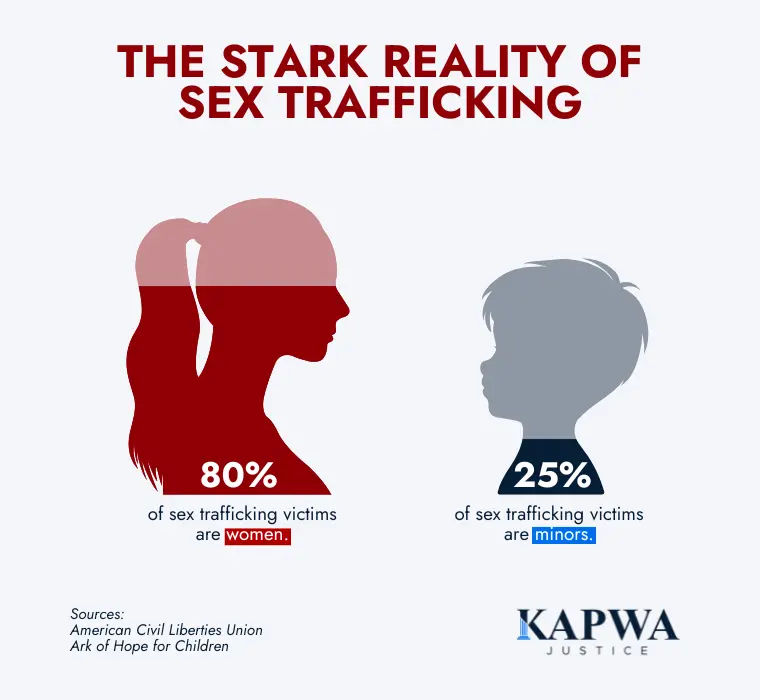Sex trafficking in the workplace is a serious issue that affects many individuals, often without being noticed. Human traffickers exploit vulnerable workers, usually manipulating them into situations of sexual exploitation and abuse.
The Filipino community in California is particularly at risk due to systemic challenges like discrimination and limited access to resources. Victims may find themselves trapped in unsafe work environments with little hope of escape.
Recognizing the signs of trafficking is vital for preventing further harm and protecting those at risk. Workers are often subjected to intimidation and control, making speaking out difficult.
This blog will help you understand how to spot the key signs of sex trafficking in the workplace and how to take action if you suspect something is wrong. Magkaisa tayo at protektahan ang bawat isa.

Warning Signs of Sex Trafficking in the Workplace
Sex trafficking involves individuals being coerced or manipulated into engaging in sexual acts for the benefit of traffickers. Victims often face severe control, isolation, and threats, with some being trapped due to factors like immigration status, fear of deportation, or lack of resources.
Here are five warning signs that someone may be experiencing sex trafficking:
1. Unusual Work Hours or Conditions
Human trafficking victims are often forced to work under extreme conditions, including unreasonable amounts of overtime or unpredictable schedules. Business owners involved in trafficking may prevent workers from leaving even during non-working hours. These instances of trafficking exploit workers’ vulnerabilities, especially those who are undocumented immigrants.
2. Fearful or Submissive Behavior
Victims in an abusive employment situation may show signs of fear or anxiety, such as avoiding eye contact or responding submissively to supervisors. This behavior often stems from threats or coercion, putting them at a heightened risk of trafficking.
3. Physical Signs of Abuse or Neglect
Human trafficking victims may display visible signs of physical abuse, such as:
- Unexplained bruises or cuts
- Injuries that appear to result from an assault
- Visible marks from control measures or excessive force
They may also suffer injuries or impairments linked to the specific nature of their job or harsh control measures. These injuries are often a direct consequence of trafficking tactics used to maintain control, such as physical punishment or unsafe working conditions.
4. Lack of Personal Freedom
Victims often face strict control over their daily lives, including being escorted to and from work. They may allow others to speak on their behalf when addressed directly, a sign of manipulation and fear.
Their actions and responses also often seem guided or instructed by someone else. Control over their movements, including constant monitoring by someone in authority, is a clear red flag of an abusive employment situation.
5. Inconsistent or Suspicious Personal Information
Victims might lack identification documents or have no control over items like passports. They may also provide inconsistent or evasive responses about their background or family, indicating they are under coercion or false promises.
Why Should You Learn the Signs?
By understanding the signs of trafficking in persons, we can better protect ourselves and others from falling victim to exploitation.
In the Filipino community in California, where many seek opportunities to improve their lives, traffickers often prey on individuals hoping for a better future. These criminals take advantage of people’s desire to escape poverty and crises by offering false promises of work or a brighter life.
Sadly, an estimated 50 million people worldwide are trapped in human trafficking, with a staggering 80% of these victims being forced into sex trafficking. Shockingly, women make up about 80% of sex trafficking victims, and a quarter of them are minors.

Raising awareness of sex trafficking not only helps prevent further exploitation but also breaks down the stigma that prevents victims from coming forward. Reporting suspicious activity is essential in the fight against trafficking, as it can save lives and prevent further harm to those trapped in inhumane conditions.
How to Report Suspicious Activity
May kilala ka bang maaaring biktima ng pang-aabuso? Reporting suspected trafficking situations can save lives. If you notice signs of modern-day slavery or suspect someone is a victim, it’s crucial to act safely and responsibly. Here’s how you can help:
- Observe and Document: Note specific details, such as the location, individuals involved, and any visible signs of physical violence or coercion.
- Contact Authorities: Report your concerns to law enforcement or call the National Human Trafficking Hotline at 1-888-373-7888. Assistance is available 24/7, and your identity can remain anonymous.
- Seek Emergency Help: If someone is in immediate danger or requires emergency medical attention, call 911. Inform responders if you suspect human trafficking concerns.
- Connect with Legal Support: If you’re unsure about coming forward, consult a sex trafficking lawyer for guidance. They can help protect your privacy and ensure your report is handled correctly.
- Reach out to Local Organizations: California has community resources and nonprofit groups dedicated to fighting trafficking. These groups can provide additional support and connect victims with services.
Your Awareness Can Save Lives
Awareness is the first step in combating sex trafficking in the workplace. Recognizing signs like restricted access to identity documents, fear of authority figures, or unusual work conditions can help uncover potential instances of exploitation. These crimes often involve the abuse of power, making it crucial for everyone to stay informed and vigilant.
If you suspect trafficking, don’t hesitate to act. Learn the signs, share this knowledge, and report any suspicious activities. Together, we can protect vulnerable individuals and create safer workplaces. If you or someone you know needs legal assistance, call us today to speak with a lawyer.




